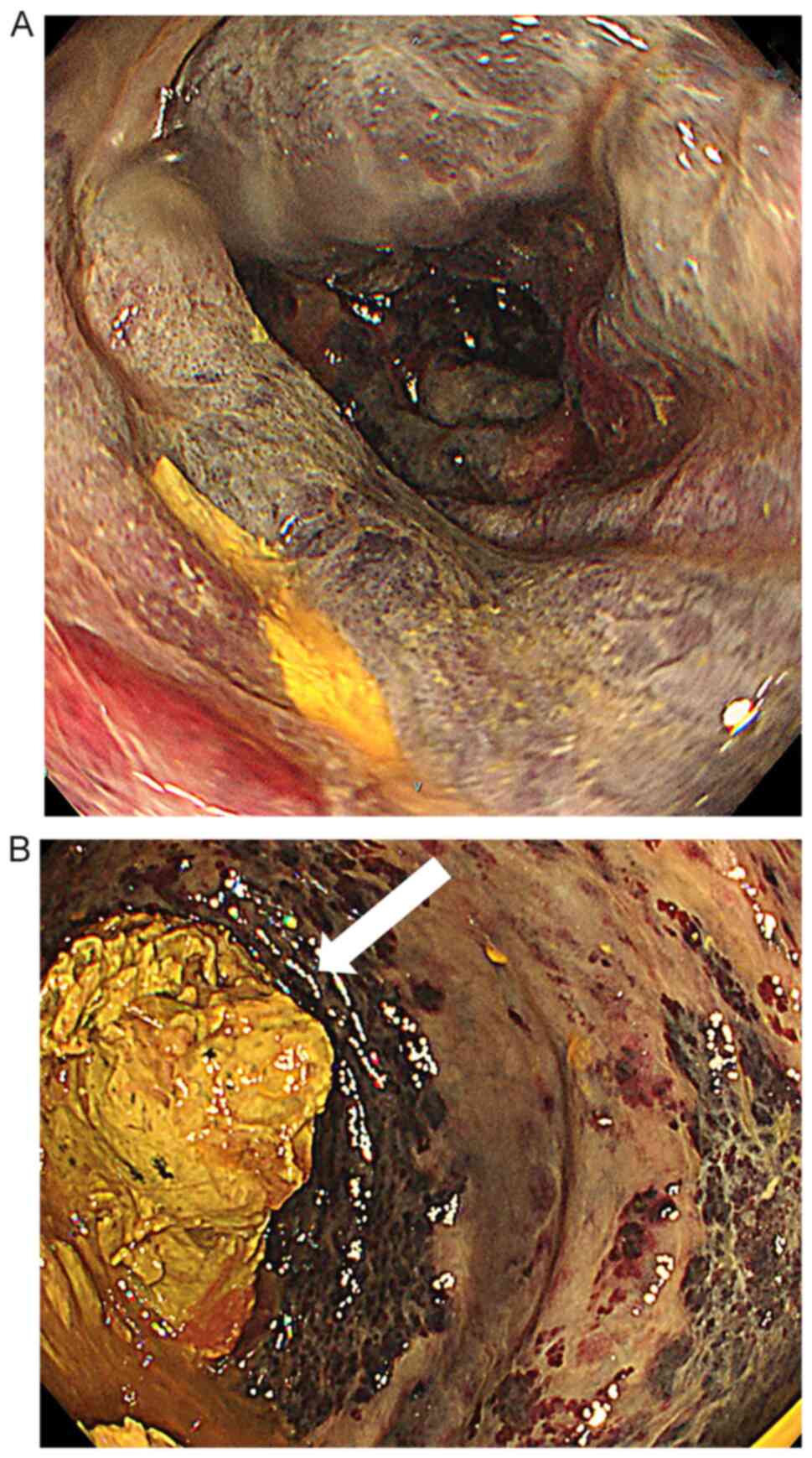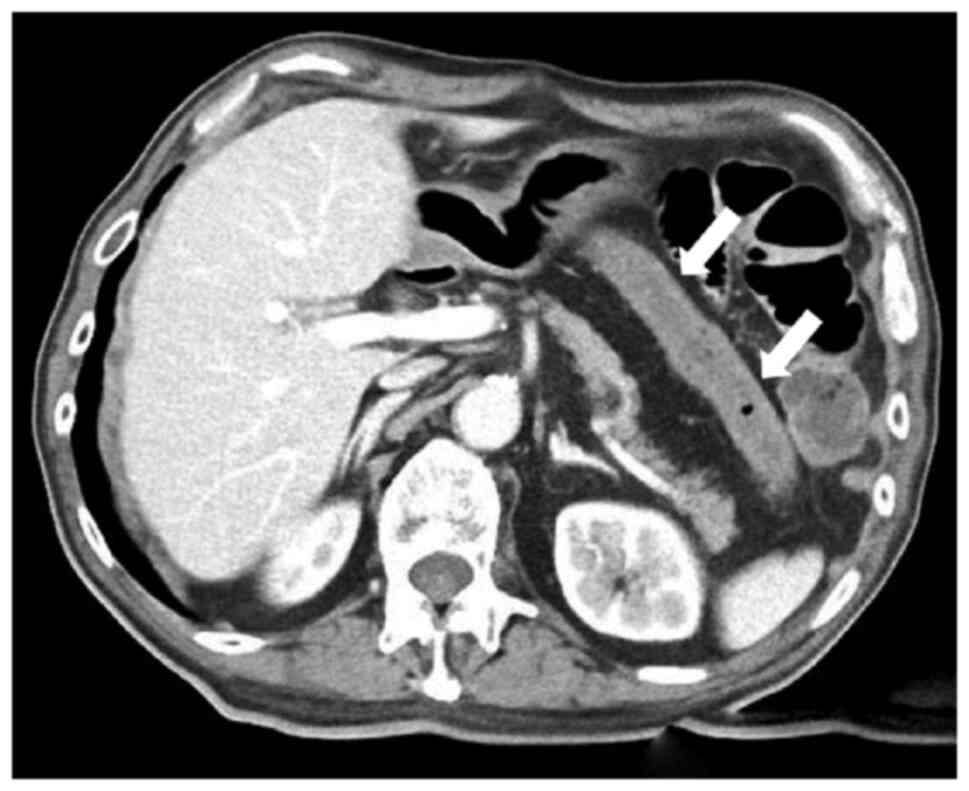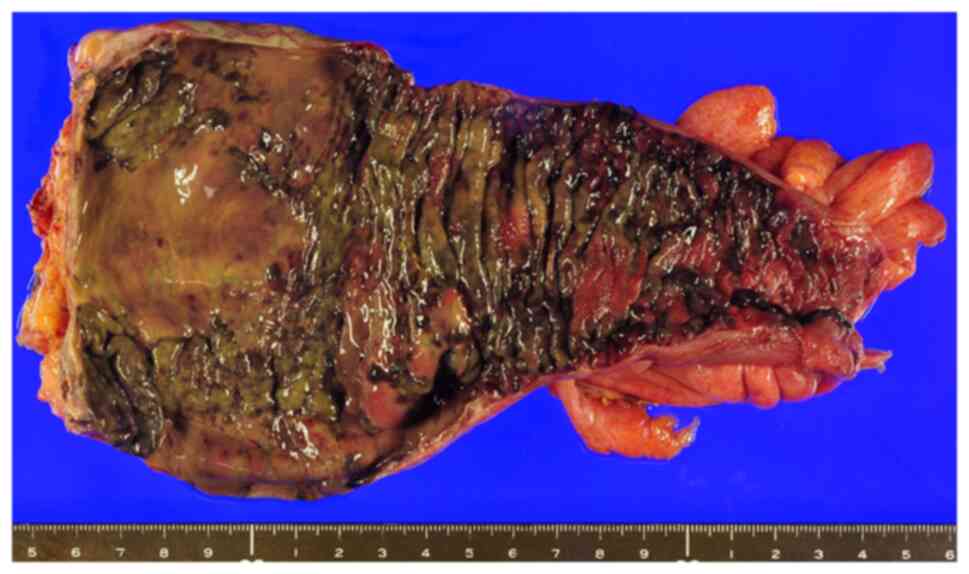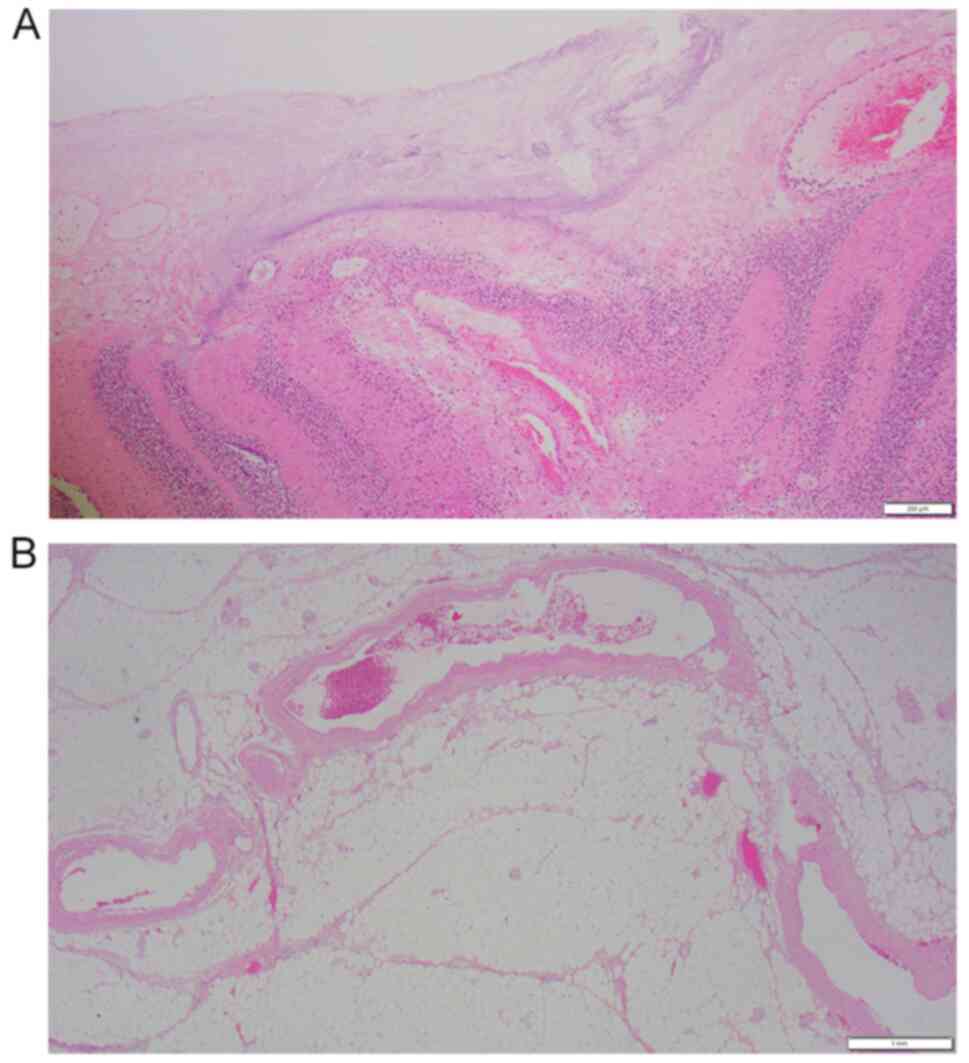Non‑obstructive mesenteric ischaemia during drug therapy for maxillary cancer: A case report
- Authors:
- Published online on: September 19, 2024 https://doi.org/10.3892/br.2024.1860
- Article Number: 172
-
Copyright: © Ikeda et al. This is an open access article distributed under the terms of Creative Commons Attribution License.
Abstract
Introduction
Non-occlusive mesenteric ischaemia (NOMI) refers to irreversible intestinal ischemia and necrosis in the absence of organic obstruction of the mesenteric blood vessels. In cases of delayed diagnosis, the prognosis is poor and the mortality rate is 58-70%, being the highest among those with acute mesenteric ischaemia (AMI) (1). The risk factors for this condition include heart disease, sepsis and the use of catecholamines and digitalis (2). The onset mechanism of NOMI involves a reduction in intestinal blood flow due to factors such as decreased cardiac output, reduced circulating blood volume, mesenteric contraction, mesenteric vasospasm caused by sepsis or the use of vasoconstrictive therapeutic agents. This pathological condition leads to diminished intestinal blood flow, ultimately resulting in intestinal ischaemia (3,4). In the early stages of onset, 20-30% of the patients do not complain of abdominal pain. When abdominal pain does occur, its location and severity can vary widely. However, as ischaemia progresses, patients typically develop persistent abdominal pain, melena and flatulence. With further disease progression, symptoms of peritoneal irritation, such as muscular guarding and Blumberg's sign, become evident (2,5). Treatment with vasodilators is considered useful if there is no intestinal necrosis; however, surgery is required if the intestinal tract has reached an irreversible ischaemic state (2,5,6). Therefore, early diagnosis of intestinal necrosis, which indicates the need for surgery, is crucial. NOMI can manifest as a shock and can be fatal, requiring immediate surgical treatment (2). The current study reported a case in which early diagnosis of NOMI allowed for emergency surgery, ultimately saving the patient's life.
Case report
The patient first presented at Toyama University Hospital (Toyama, Japan) in January 2022 with the chief complaint of a painful tumour in the right cheek without an ulcer. The tumour was elastic, firm and immobile, measuring 65x50 mm. Right maxillary carcinoma (cT4bN1M0) was confirmed according to imaging and histopathological examinations. The patient's medical history included cerebral haemorrhage (left paresis), early gastric cancer, colon polyps, hypertension and dementia. Since the tumour was deemed unresectable, paclitaxel, carboplatin and cetuximab (PCE) was administered as induction drug therapy. Although drug therapy was successful and CT revealed the lesion was observed to shrink after the first course of PCE therapy, the patient visited the emergency department of our hospital with chief complaints of melena and abdominal pain 4 days after day 1 of the second course of PCE therapy. Upon transportation to our hospital, the patient's Glasgow Coma Scale level of consciousness was E4V4M6 (Score: 14, mild) (7), oxygen saturation was 90% (normal range, 96-99% under room air), blood pressure was 92/52 mmHg (normal value, 140/90 mmHg) and the heart rate was 111 bpm (normal range, 60-100 bpm); furthermore, the patient experienced a peripheral cold sensation. In addition, the abdomen was flat, elastic and soft with no tenderness, and blood gas analysis revealed pH of 7.385 (normal range, 7.35-7.45) and lactic acid level of 4.8 mmol/l (normal range, 0.5-1.6 mmol/l). Based on these findings, the patient was diagnosed with circulatory failure due to bleeding. Lower gastrointestinal endoscopy, performed to investigate the bleeding points, revealed oedema and dark purple discoloration of the intestinal mucosa, as well as a large amount of faeces in the rectum (Fig. 1). Acute intestinal ischaemia was diagnosed and contrast-enhanced CT was performed to check for arterial occlusion due to the thrombus. Although the images showed ischaemia from the transverse to descending colon (Fig. 2), no thrombus was found in the superior mesenteric artery. At that time, the abdomen was slightly hard and tender. Based on these findings, the patient was diagnosed with NOMI. Emergency surgery, including colectomy (from the sigmoid colon to the sigmoid rectum) and colostomy augmentation, was performed on the same day. The resected specimen showed full-thickness necrosis of the sigmoid rectum (Fig. 3). Histopathological examination performed according to standard procedures showed massive necrosis of the colon and proliferation of neutrophils. No thrombi were observed in the blood vessels directly beneath the necrotic mucosa, and the lumen remained patent (Fig. 4). Thereafter, the patient's general condition improved and no further increase of the lesion in the right maxillary region was observed. However, owing to a decline in cognitive function and the presence of aspiration pneumonia, the patient's performance status (8) decreased from 2 to 3 and he was transferred to a recuperation facility for palliative care. The patient's subsequent progress is unknown.
Discussion
NOMI was first reported in 1958 by Ende (9) in a patient with intestinal necrosis and heart failure. NOMI is known to cause ischaemia or necrosis of the intestinal tract, despite the absence of organic obstruction of the main mesenteric blood vessels. Heer et al (10) defined NOMI as follows: i) No obstruction in the mesenteric arteries and veins in areas of intestinal necrosis; ii) discontinuous necrosis and ischaemic changes in the intestinal tract; and iii) histopathological findings showing the presence of bleeding and necrosis. However, it is defined by the lack of fibrin thrombus in the venules (10). The onset mechanism of NOMI involves a reduction in intestinal blood flow due to factors such as decreased cardiac output, reduced circulating blood volume, mesenteric contraction and mesenteric vasospasm caused by sepsis or the use of vasoconstrictive therapeutic agents. This pathological condition leads to diminished intestinal blood flow, ultimately resulting in intestinal ischaemia (3,4). Furthermore, rapid acceleration of intestinal peristalsis and an increase in intestinal pressure caused by faecal impaction or enema has been reported to cause intestinal ischaemia (11). The risk factors for NOMI include cardiovascular disease, myocardial infarction, sepsis, arrhythmia and the use of catecholamines or digitalis (2). A search in PubMed (https://pubmed.ncbi.nlm.nih.gov) and J-stage (https://www.jstage.jst.go.jp) for the search terms (NOMI and chemotherapy) retrieved reports of only 15 cases of NOMI due to chemotherapy (Table I) (5,12-21). The reason why most of the reported cases are Japanese is unclear and further investigation is needed. Docetaxel was used in six cases, paclitaxel in three cases and taxane-based anticancer drugs were used in nine cases. The onset of NOMI after chemotherapy has been linked to several factors: Mucosal damage due to the inhibition of epithelial cell division and proliferation, a pharmacological effect of taxane-based anticancer drugs (22); and vascular system damage resulting from the inhibition of vascular smooth muscle cell proliferation and migration and neointimal accumulation (23). The intestinal mucosa repeatedly regenerates every 3rd to 4th day and intestinal mucosal damage appears after the 3rd to 4th day of administration due to the suppression of intestinal epithelial cell division and proliferation by taxane-based anticancer drugs. The increased intestinal pressure caused by chemotherapy-induced constipation contributes to the onset of NOMI (5). Taxane-based anticancer drugs have been approved for use against a wide range of malignant tumours, including ovarian, breast and head and neck cancers. Intestinal disorders such as gastrointestinal necrosis, perforation, bleeding, ulcers and severe enteritis have been reported, although at a low incidence (<0.1%) (24). However, in the case of ischaemic colitis due to taxane-based anticancer drugs, drug discontinuation has been found to ameliorate the symptoms; in such cases, the causative drug should not be re-administered (25). Seewaldt et al (26) reported that paclitaxel-induced intestinal necrosis is caused not only by toxicity to the intestinal epithelium, but also by a history of laparotomy, cancer progression, intraperitoneal radiotherapy and chemotherapy. Intestinal necrosis occurs because of the effects of paclitaxel on the intestinal epithelium in the intestinal tract, where mucosal damage occurs. In the present case, the patient had a history of surgery for colonic polyps and the necrotic segment of the colon that was resected was the same segment previously containing the polyps. Therefore, intestinal mucosal damage had already occurred. In this case, the administration of anticancer drugs was thought to be the cause of intestinal necrosis. Furthermore, lower gastrointestinal endoscopy revealed a large amount of stool, and increased intestinal pressure owing to constipation was considered a contributing factor to the onset of NOMI. In cases of delayed diagnosis, the prognosis is poor, with a mortality rate of 58-70%, being the highest for those with AMI (1). The underlying reason for this is the lack of distinctive clinical symptoms, leading to a delayed diagnosis (27). In the early stages of onset, 20-30% of the patients do not complain of abdominal pain. When abdominal pain does occur, its location and severity can vary widely. However, as ischaemia progresses, patients typically develop persistent abdominal pain, melena and flatulence. With further disease progression, symptoms of peritoneal irritation, such as muscular guarding and Blumberg's sign, become evident (2,5). Blood tests show elevated levels of C-reactive protein, aspartate aminotransferase, alanine aminotransferase, creatine phosphokinase, lactate dehydrogenase and lactate, as well as metabolic acidosis, but these are not specific to the diagnosis of NOMI (2). The usefulness of CT in the diagnosis of NOMI has been reported (29). In the past, diagnosis with CT was considered difficult, but in recent years, advances in multidetector-CT have improved the ability to visualise blood flow in the blood vessels, intestines and mesentery, thereby improving the diagnostic performance. Contrast-enhanced CT is essential for diagnosis, and findings, such as decreased or absent contrast effects on the intestinal wall, which are signs of intestinal ischaemia, can be observed. In the present case, NOMI was suspected and additional contrast-enhanced CT revealed ischaemia from the transverse colon to the descending colon. Treatment with vasodilators is considered useful if there is no intestinal necrosis; however, surgery is required if the intestinal tract has reached an irreversible ischaemic state (2,5,6). Therefore, early diagnosis of intestinal necrosis, which indicates the need for surgery, is crucial. NOMI can manifest as a shock and can be fatal, requiring immediate surgical treatment (2). If abdominal symptoms such as abdominal pain and vomiting occur during drug therapy, intestinal ischaemia should be suspected and discontinuation of anticancer drugs should be considered.
In conclusion, if a patient has a history of abdominal surgery or evidence of intestinal mucosal disorders (such as constipation), early imaging examinations (including contrast-enhanced CT) and consultation with a gastroenterologist should be considered to rule out NOMI.
Acknowledgements
The authors express their great appreciation to Professor Kenichi Hirabayashi (Department of Diagnostic Pathology, Faculty of Medicine, University of Toyama, Toyoma, Japan) and Dr Takashi Minamisaka (Department of Diagnostic Pathology, Toyama University Hospital, Toyoma, Japan) for histopathological analysis.
Funding
Funding: No funding was received.
Availability of data and materials
The data generated in the present study may be requested from the corresponding author.
Authors' contributions
AI, RI, KS, DT, MT and SY treated the patient with PCE. AI, KS and KF performed the follow-up. AI, SY, RI and MN drafted the manuscript. AI, RI, SY and MN prepared the figures and table. AI, SY and MN confirm the authenticity of all the raw data. All authors have read and approved the final version of the manuscript.
Ethics approval and consent to participate
Not applicable.
Patient consent for publication
Written informed consent was obtained from the patient for the publication of this case report and the accompanying images.
Competing interests
The authors declare that they have no competing interests.
References
|
Mazzei MA, Guerrini S, Cioffi Squitieri N, Vindigni C, Imbriaco G, Gentli F, Berritto D, Mazzei FG, Grassi R and Volterrani L: Reperfusion in non-occlusive mesenteric ischaemia (NOMI): Effectiveness of CT in an emergency setting. Br J Radiol. 89(20150956)2016.PubMed/NCBI View Article : Google Scholar | |
|
Suzuki S, Kondo H, Furukawa A, Kawai K, Yamamoto M and Hirata K: The treatment and diagnosis of non-occlusive mesenteric ischemia (NOMI). J Abdom Emerg Med. 35:177–185. 2015. | |
|
Wiesner W, Khurana B, Ji H and Ros PR: CT of acute bowel ischemia. Radiology. 226:635–650. 2003.PubMed/NCBI View Article : Google Scholar | |
|
Furukawa A, Kanasaki S, Kono N, Wakamiya M, Tanaka T, Takahashi M and Murata K: CT diagnosis of acute mesenteric ischemia from various causes. AJR Am J Roentgenol. 192:408–416. 2009.PubMed/NCBI View Article : Google Scholar | |
|
Yoshida M, Kobayashi T and Hyodo M: Two cases of non-occlusive mesenteric ischemia after chemotherapy for head and neck cancer. Pract Oto-Rinno-Laryngol. 113:175–181. 2020. | |
|
Yukaya T, Kajiyama K, Koga C, Abe T, Harimoto N, Miyazaki M, Yamashita T, Kai M, Shirabe K and Nagaie T: Study of predictive factors for the prognosis in patients with non occlusive mesenteric ischemia (NOMI). J Abdom Emerg Med. 31:1009–1014. 2011. | |
|
Teasdale G and Jennett B: Assessment of coma and impaired consciousness. A practical scale. Lancet. 2:81–84. 1974.PubMed/NCBI View Article : Google Scholar | |
|
Oken MM, Creech RH, Tormey DC, Horton J, Davis TE, McFadden ET and Carbone PP: Toxicity and response criteria of the eastern cooperative oncology group. Am J Clin Oncol. 5:649–655. 1982.PubMed/NCBI | |
|
Ende N: Infarction of the bowel in cardiac failure. N Engl J Med. 258:879–881. 1958.PubMed/NCBI View Article : Google Scholar | |
|
Heer FE, Silen W and French SW: Intestinal gangrene without apparent vascular occlusion. Am J Surg. 110:231–238. 1965.PubMed/NCBI View Article : Google Scholar | |
|
Yamakoshi H, Kanai T, Kurihara H, Ishikawa T, Ozawa K and Ueno H: Clinical study on forty-six cases of ischemic colitis. J Jpn Soc Coloproctol. 55:307–312. 2002. | |
|
Pearson AC, Steinberg S, Shah MH and Bloomston M: The complicated management of a patient following transarterial chemoembolization for metastatic carcinoid. World J Surg Oncol. 6(125)2008.PubMed/NCBI View Article : Google Scholar | |
|
Tanaka H, Tsukahara K, Okamoto I, Kojima R, Hirasawa K and Sato H: A case of septicemia due to nonocclusive mesenteric ischemia occurring in induction chemotherapy. Case Rep Otolaryngol. 2018(7426819)2018.PubMed/NCBI View Article : Google Scholar | |
|
Wada T, Katsumata K, Kuwahara H, Matsudo T, Murakoshi Y, Shigoka M, Enomoto M, Ishizaki T, Kasuya K and Tsuchida A: Two cases of non-occlusive mesenteric ischemia that developed after chemotherapy. Gan To Kagaku Ryoho. 44:1396–1398. 2017.PubMed/NCBI(In Japanese). | |
|
Ikeda K, Hanba H, Nagano k, Shimizu S, Nakazawa K, Nishiguchi Y, Ogawa Y and Inoue K: Paclitaxel (Taxol) associated bowels necrosis in the patient with local progressive breast cancer. J Jpn Coll Surg. 32:638–642. 2007. | |
|
Awano N, Kondoh K, Andoh T, Ikushima S, Kumasaka T and Takemura T: Three cases of lung carcinoma complicated by gastrointestinal necrosis and perforation. Jpn J Lung Cancer. 53:809–814. 2013. | |
|
Matsuzawa M, Harada K, Hosomura N, Amemiya H, Ando N, Inozume T, Kawamura T, Shibasaki N and Shimada S: Non-occlusive mesenteric ischemia after chemotherapy for metastatic melanoma. J Dermatol. 42:105–106. 2015.PubMed/NCBI View Article : Google Scholar | |
|
Yamane H, Fukuda N, Nishino K, Yoshida K, Ochi N, Yamagishi T, Honda Y, Kawamoto H, Monobe Y, Mimura H, et al: Non-occlusive mesenteric ischemia after splenic metastasectomy for small-cell lung cancer. Intern Med. 54:743–747. 2015.PubMed/NCBI View Article : Google Scholar | |
|
Nagano H, Fujiwara Y, Matsuzaki H, Umakoshi M, Ohori J and Kurono Y: Three cases of non-occlusive mesenteric ischemia that developed after head and neck cancer therapy. Auris Nasus Larynx. 48:1193–1198. 2021.PubMed/NCBI View Article : Google Scholar | |
|
Kuwayama N, Hoshino I, Gunji H, Kurosaki T, Nabeya Y and Takayama W: A case of NOMI during treatment with nivolumab for recurrent Hodgkin lymphoma. J Jpn Surg Assoc. 83:92–97. 2022. | |
|
Oikawa N, Kinoshita M, Yamamura M, Uno T, Ichinose T, Sabit H, Hayashi T, Inoue D, Harada K and Nakada M: Non-occlusive mesenteric ischemia during bevacizumab treatment for glioblastoma: A case report. Acta Neurochir (Wien). 164:2767–2771. 2022.PubMed/NCBI View Article : Google Scholar | |
|
Klauber N, Parangi S, Flynn E, Hamel E and D'Amato RJ: Inhibition of angiogenesis and breast cancer in mice by the microtubule inhibitors 2-methoxyestradiol and taxol. Cancer Res. 57:81–86. 1997.PubMed/NCBI | |
|
Britt LG and Cheek RC: Nonocclusive mesenteric vascular disease: Clinical and experimental observations. Ann Surg. 169:704–711. 1969.PubMed/NCBI View Article : Google Scholar | |
|
Kikuchi O, Saito D, Ikezaki O, Mitsui T, Miura M, Sakuraba A, Yamada Y, Hayashida M, koyama G, et al: A case of Ischemic colitis occurring in chemotherapy for ovarian cancer. Prog Dig Endosc. 88:69–72, 61. 2016. | |
|
Nakamura S, Nogami K, Hida N, Iimuro M, Yokoyama Y, Kamikozuru K, Nakamura M, Kawai M, Fukunaga K, et al: Two cases of ischemic colitis associated with paclitaxel-based chemotherapy in patients with ovarian cancer. 48:1785–1790. 2013. | |
|
Seewaldt VL, Cain JM, Goff BA, Tamimi H, Greer B and Figge D: A retrospective review of paclitaxel-associated gastrointestinal necrosis in patients with epithelial ovarian cancer. Gynecol Oncol. 67:137–140. 1997.PubMed/NCBI View Article : Google Scholar | |
|
Al-Diery H, Phillips A, Evennett N, Pandanaboyana S, Gilham M and Windsor JA: The pathogenesis of nonocclusive mesenteric ischemia: Implications for research and clinical practice. J Intensive Care Med. 34:771–781. 2019.PubMed/NCBI View Article : Google Scholar | |
|
Mitsuyoshi A, Obama K, Shinkura N, Ito T and Zaima M: Survival in nonocclusive mesenteric ischemia: Early diagnosis by multidetector row computed tomography and early treatment with continuous intravenous high-dose prostaglandin E(1). Ann Sur. 246:229–235. 2007.PubMed/NCBI View Article : Google Scholar | |
|
Woodhams R, Nishimaki H, Fujii K, Kakita S and Hayakawa K: Usefulness of multidetector-row CT (MDCT) for the diagnosis of non-occlusive mesenteric ischemia (NOMI): Assessment of morphology and diameter of the superior mesenteric artery (SMA) on multi-planar reconstructed (MPR) images. Eur J of Radio. 76:96–102. 2010.PubMed/NCBI View Article : Google Scholar |













